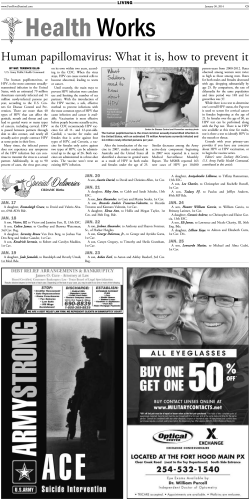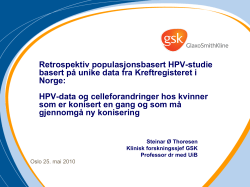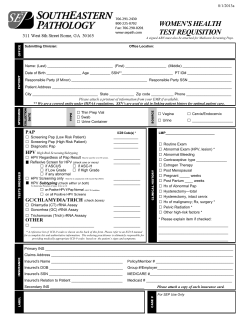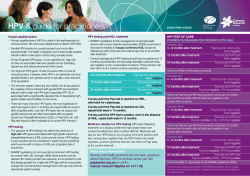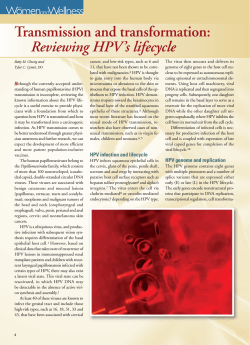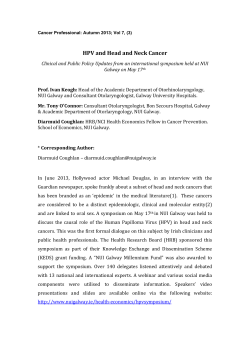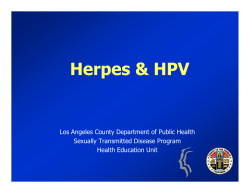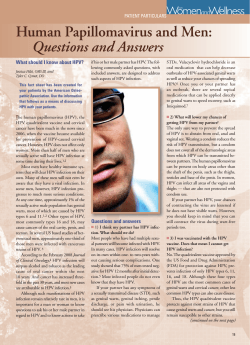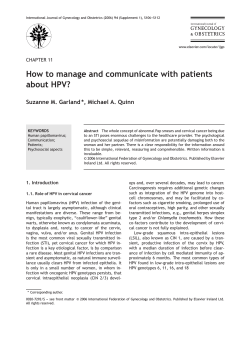
Management of Abnormal PAP Smears K Chacko, MD, FACP 2010
Management of Abnormal PAP Smears K Chacko, MD, FACP 2010 GIM Conference Scope of the Problem • About 7-10% of PAPs will come back abnormal • 3.5 to 4 million in the US each year • Approximate 4000 deaths per year (2009) • Expert guidelines developed to standardize how we manage these Why do we Care? • Cervical cancer ranks 13th in cancer deaths in • • • the US (13,000 cases, 4100 deaths) 60% of these occur in women who haven’t been screened or not screened within the past 5 years 93-100% of cervical cancers are linked to HPV Liquid-based (ThinPrep) test is 80% sensitive Screening • Start at age 21 (this may change in the era of • • HPV vaccination…) Stop at 65 (USPSTF) to 70 (ACS, ACOG 65-70) assuming not high risk and normal exams in past 10 years (high risk are women without usual source of care and immigrants) Post-hysterectomy for benign disease and cervix removed, no recent HPV or high grade dysplasia – stop Screening - testing • Do not do HPV testing in adolescents (defined in • • studies as <21) Do not do primary/routine HPV testing in women age 21-29 (low specificity for disease). Order reflex HPV for ASCUS Do primary HPV testing with PAP smear for women >30 or PAP alone Screening Interval • Women >30 with dual negative (HPV and • • • cytology) can do q 3 years (or longer) Low risk women over 30 can have extended screening 2-3 yrs without HPV typing- just negative pap Age 21-29 with negative cytology (do not do routine HPV in this group), q 2 years Both above assume no high risk conditions (HIV, immunocompromise, h/o cervical cancer, in utero DES exposure) PAP Report • Adequacy • Optional (organisms/inflammation) • Epithelial abnormalities • Type of PAP (liquid/conventional) Adequacy of Specimen • Measure of adequacy: 5000 cells LBP or 8-12 K • • • conventional PAP –helpful if 10 endocervical or squamous metaplastic cells are present as well Unsatisfactory means >75% of cells are uninterpretable (blood,inflammation, debris). Repeat in 2-4 months. Partially obscuring blood – repeat in 6 months (when 50-75% of cells are obscured but not >75%) No endocervical cells present Unsatisfactory and Reactive • Unsatisfactory – repeat in 2-4 months • Reactive – do nothing (treat as normal) unless patient with HIV in which case repeat PAP in 4-6 months No Endocervical Cells • Repeat in 6 months if: • If none of the criteria for 6 month screening • Abnl PAP in past 3 • • • • • years Any previous glandular abnl. HPV+ in past year Exam notes inability to see or sample the canal Previous ASCUS and lack of 2 normal PAPs since Insufficient recent screening met, then repeat in one year Endocervical Cells • Can give pt 400 mcg Cytotec (misoprostol) to apply cervically 4 hours before clinic visit to increase chances that endocervix opens up • Mild cramping, use NSAIDs Endometrial cells in woman >40 • More common when doing liquid based testing • More common if PAP is done in first half of • • • menstrual cycle versus latter half If the patient is pre-menopausal, cells are benign, and no abnl bleeding, do nothing If post-menopausal need endometrial office biopsy Any woman >40 with this finding who has abnl bleeding needs endometrial assessment or if high risk for endometrial CA (tamoxifen, estrogen therapy, anovulation, obesity, personal history of ovarian breast colon cancer) Organisms • Shift in flora suggesting BV • Candida • Actinomyces • Trichomonas • Changes suggesting HSV infection STD Screening • Reminder that we should be screening all • • women <25 years old annually for Chlamydia or anyone with a new partner, multiple partners, other risk factors HPV is the most common STD Trich is the 2nd most common STD Candida • Do not have to treat • If noted at exam, should treat at the time of • • visit Approximately 3% of PAPs In one study, any PAP with candida contacted for f/u, >70% asymptomatic Actinomyces • A normal part of gi and vaginal flora • Does not have to be treated, even if patient has an IUD in place, unless symptomatic Bacterial Vaginosis • Does not have to be treated unless symptomatic • • or severe inflammation More frequent in those whose report comes back as HSIL Treatment is metronidazole vaginally for 5 nights or clindamycin vaginally for 3-7 nights Trichomonas • Should be treated in all patients • Sensitivity 61%, specificity 99%, PPV 96% • Treatment is oral metronidazole only – either 2 • gm po once or 500 bid for 7 days Partner notification and treatment is necessary For all with inflammation • No need to repeat PAP until 1 year unless HIV • positive or otherwise immunosuppressed (in which case they need repeat PAP in 6 months) If atrophy is also noted, can consider estrogen cream (postmenopausal) Epithelial Abnormalities • ASC-US • ASC-H • LGSIL • HGSIL • AGC ASC • Separate in to ASC-US or –H • Anywhere from 3-4% of PAPs • 3-15% of ASCUS have a high-grade lesion • ASC-H indicates pathologists concern for • dysplasia In adolescents, repeat in one year (do not do HPV and ignore if happen to have + result). In others, reflex HPV guides decision for repeat in one year (negative HPV) versus colpo (HPV positive). ASC-H goes to colpo. LGSIL • 2% of PAP results • Incorporates CIN I, mild dysplasia, changes c/w • • • HPV infection 15-30% actually have HGSIL on colpo biopsy LSIL goes to colpo with ECC performed if no obvious lesion (not in pregnancy) except in adolescents in whom you do not HPV type and this result means repeat in one year and menopausal pts in whom HPV + goes to colpo but HPV neg can re-PAP in one year If negative colpo, re-PAP in 6 and 12 months HGSIL • <1% of PAP results • Incorporates CIN II/III, moderate to severe • • • dysplasia, and carcinoma in situ More than 50% have HGSIL on biopsy 1-2% have cancer HGSIL to colpo and if negative or CIN 1 to LOOP – less aggressive with LOOP in younger patients or those who want to have kids in future AGC • <1% of PAPs • Underlying rate of CIN 9-50%, AIS • • (adenocarcinoma in situ) up to 8%, CA 1-9% Endometrial or endocervical cells may be noted Persistent AGC after gyn eval requires RF to gyn onc as they could be from other gyn sources Epithelial Cell Abnormalities ASC-H ASC-US LSIL Colpo and ECC HPV not done Reflex HPV Positive To colpo* Negative – Re-PAP in One year Repeat PAP In 4-6 months ASCUS or Higher to colpo Negative Repeat in 6 months AGC AIS HSIL Endometrial Cells present Colpo,ECC Colpo and if No lesion Seen, then ECC* Neg colpo Re-PAP 6,12 mo. Pos colpo To gyn for tx no Neg colpo or CINI, 6 mo. colpo/ECC Colpo pos ECC neg Re-PAP 4,8,12 mo. Age<35 NO Colpo,ECC Endomet bx Yes and no Irreg bleeding Colpo, ECC Yes – Endomet Biopsy, Colpo/ECC Adolescents (* from graph) • In adolescents, since HPV is believed to be • transient and less infective, for both ASCUS-HPV positive and LSIL, it is OK to simply repeat PAP in 12 months and not refer for colpo Routine HPV testing in adolescents not recommended Side notes • LSIL (* also on graph) in post-menopausal can use HPV to triage. HPV + to colpo and HPV neg can re-PAP in one year • ASC-US in HIV positive women. Controversy – colposcopy association notes use HPV reflex as in non-HIV infected women. IDSA notes all ASC-US goes to colpo. Type Specific HPV testing • March 2009 FDA approved screening test for HRHPV 16 & 18 to recognize those with HRHPV at highest risk. Risk of Cervical Dysplasia or Cancer with HPV 16/18 HPV Genotyping • HRHPV 16 & 18 specific • Approved for use in screening women >30 with normal cytology and HRHPV+ • Approved for adjunct testing in women with ASC-US screening pap Genotyping in Women with ASC-US • HPV 16/18 would be used when pap is ASC-US and +HRHPV. If HPV 16/18+ colpo if negative rescreen 12 months • ASCCP guidelines do not support use of 16/18 type specific testing for triaging ASC-US paps • ALTS data: ASC-US HPV 16 or 18 positive: 40% CIN2+ ASC-US non 16/18 HRHPV +: 20% CIN2+ Thanks • Ches Thompson, MD in Ob/Gyn • Questions???
© Copyright 2026


